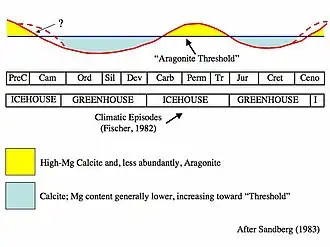Aragonite sea
An aragonite sea contains aragonite and high-magnesium calcite as the primary inorganic calcium carbonate precipitates. The chemical conditions of the seawater must be notably high in magnesium content relative to calcium (high Mg/Ca ratio) for an aragonite sea to form. This is in contrast to a calcite sea in which seawater low in magnesium content relative to calcium (low Mg/Ca ratio) favors the formation of low-magnesium calcite as the primary inorganic marine calcium carbonate precipitate.

The Early Paleozoic and the Middle to Late Mesozoic oceans were predominantly calcite seas, whereas the Middle Paleozoic through the Early Mesozoic and the Cenozoic (including today) are characterized by aragonite seas.[1][2][3][4][5][6][7][8]
Aragonite seas occur due to several factors, the most obvious of these is a high seawater Mg/Ca ratio (Mg/Ca > 2), which occurs during intervals of slow seafloor spreading.[4] However, the sea level, temperature, and calcium carbonate saturation state of the surrounding system also determine which polymorph of calcium carbonate (aragonite, low-magnesium calcite, high-magnesium calcite) will form.[9][10]
Likewise, the occurrence of calcite seas is controlled by the same suite of factors controlling aragonite seas, with the most obvious being a low seawater Mg/Ca ratio (Mg/Ca < 2), which occurs during intervals of rapid seafloor spreading.[4][8]
This trend has been observed by looking at the chemistry of both biogenic and abiogenic carbonates, dating them, and analyzing the conditions under which they were formed. Various studies have examined these relationships and concluded that the mineralogy of both biogenic (major carbonate sediment and rock-forming organisms)[8] and abiogenic marine carbonates (limestones and marls)[11] throughout Phanerozoic time has generally been synchronized with calcium carbonate mineralogies expected from seawater magnesium/calcium ratios reconstructed from derivatives of ancient seawater trapped in halite crystals in the geologic record (fluid inclusions).[5]
Citations
- Wilkinson, Owen & Carroll 1985
- Wilkinson & Given 1986
- Morse & Mackenzie 1990
- Hardie 1996
- Lowenstein et al. 2001
- Hardie 2003
- Palmer & Wilson 2004
- Ries, J. (2010). "Geological and experimental evidence for secular variation in seawater Mg/Ca (calcite-aragonite seas) and its effects on marine biological calcification". Biogeosciences. 7 (9): 2795–2849. Bibcode:2010BGeo....7.2795R. doi:10.5194/bg-7-2795-2010.
- Adabi 2004
- Ries, J. (2011). "Skeletal mineralogy in a high-CO2 world". Journal of Experimental Marine Biology and Ecology. 403 (1–2): 54–64. doi:10.1016/j.jembe.2011.04.006.
- Westphall & Munnecke 2003
References
- Adabi, Mohammad H. (2004), "A re-evaluation of aragonite versus calcite seas", Carbonates and Evaporites, 19 (2): 133–141, doi:10.1007/BF03178476, S2CID 128955184
- Cherns, L.; Wright, V.P. (2000). "Missing molluscs as evidence of large-scale, early skeletal aragonite dissolution in a Silurian Sea". Geology. 28 (9): 791–794. Bibcode:2000Geo....28..791C. doi:10.1130/0091-7613(2000)28<791:MMAEOL>2.0.CO;2. ISSN 0091-7613.
- Hardie, Lawrence A (1996), "Secular variation in seawater chemistry: An explanation for the coupled secular variation in the mineralogies of marine limestones and potash evaporites over the past 600 my", Geology, Geological Society of America, 24 (3): 279–283, Bibcode:1996Geo....24..279H, doi:10.1130/0091-7613(1996)024<0279:svisca>2.3.co;2
- Hardie, Lawrence A. (2003), "Secular variations in Precambrian seawater chemistry and the timing of Precambrian aragonite seas and calcite seas", Geology, 31 (9): 785–788, Bibcode:2003Geo....31..785H, doi:10.1130/g19657.1
- Harper, E.M.; Palmer, T.J.; Alphey, J.R. (1997). "Evolutionary response by bivalves to changing Phanerozoic sea-water chemistry". Geological Magazine. 134 (3): 403–407. Bibcode:1997GeoM..134..403H. doi:10.1017/S0016756897007061. S2CID 140646397.
- Lowenstein, T.K.; Timofeeff, M.N.; Brennan, S.T.; Hardie, L.A.; Demicco, R.V. (2001), "Oscillations in Phanerozoic seawater chemistry: evidence from fluid inclusions", Science, 294 (5544): 1086–1088, Bibcode:2001Sci...294.1086L, doi:10.1126/science.1064280, PMID 11691988, S2CID 2680231
- Morse, J.W.; Mackenzie, F.T. (1990). "Geochemistry of sedimentary carbonates". Developments in Sedimentology. 48: 1–707. doi:10.1016/S0070-4571(08)70330-3.
- Palmer, T.J.; Wilson, M.A. (2004). "Calcite precipitation and dissolution of biogenic aragonite in shallow Ordovician calcite seas". Lethaia. 37 (4): 417–427 . doi:10.1080/00241160410002135.
- Palmer, T.J. (1982). "Cambrian to Cretaceous changes in hardground communities". Lethaia. 15 (4): 309–323. doi:10.1111/j.1502-3931.1982.tb01696.x.
- Palmer, T.J.; Hudson, J.D.; Wilson, M.A. (1988). "Palaeoecological evidence for early aragonite dissolution in ancient calcite seas". Nature. 335 (6193): 809–810. Bibcode:1988Natur.335..809P. doi:10.1038/335809a0. S2CID 4280692.
- Pojeta J. Jr. (1988). "Review of Ordovician pelecypods". U.S. Geological Survey Professional Paper. 1044: 1–46.
- Porter, S.M. (2007). "Seawater chemistry and early carbonate biomineralization". Science. 316 (5829): 1302–1304. Bibcode:2007Sci...316.1302P. doi:10.1126/science.1137284. PMID 17540895. S2CID 27418253.
- Sandberg, P.A. (1983). "An oscillating trend in Phanerozoic non-skeletal carbonate mineralogy". Nature. 305 (5929): 19–22. Bibcode:1983Natur.305...19S. doi:10.1038/305019a0. S2CID 4368105.
- Stanley, S.M.; Hardie, L.A. (1998), "Secular oscillations in the carbonate mineralogy of reef-building and sediment-producing organisms driven by tectonically forced shifts in seawater chemistry", Palaeogeography, Palaeoclimatology, Palaeoecology, 144 (1–2): 3–19, Bibcode:1998PPP...144....3S, doi:10.1016/S0031-0182(98)00109-6
- Stanley, S.M.; Hardie, L.A. (1999), "Hypercalcification; paleontology links plate tectonics and geochemistry to sedimentology", GSA Today, 9: 1–7
- Westphall, H.; Munnecke, A. (2003). "Limestone-marl alternations: A warm-water phenomenon?". Geology. 31 (3): 263–266. Bibcode:2003Geo....31..263W. doi:10.1130/0091-7613(2003)031<0263:LMAAWW>2.0.CO;2. ISSN 0091-7613.
- Wilkinson, B.H. (1979), "Biomineralization, paleooceanography, and the evolution of calcareous marine organisms", Geology, 7 (11): 524–527, Bibcode:1979Geo.....7..524W, doi:10.1130/0091-7613(1979)7<524:BPATEO>2.0.CO;2, ISSN 0091-7613
- Wilkinson, B.H.; Given, K.R. (1986). "Secular variation in abiotic marine carbonates: constraints on Phanerozoic atmospheric carbon dioxide contents and oceanic Mg/Ca ratios". Journal of Geology. 94 (3): 321–333. Bibcode:1986JG.....94..321W. doi:10.1086/629032. S2CID 128840375.
- Wilkinson, B.H.; Owen, R.M.; Carroll, A.R. (1985). "Submarine hydrothermal weathering, global eustacy, and carbonate polymorphism in Phanerozoic marine oolites". Journal of Sedimentary Petrology. 55: 171–183. doi:10.1306/212f8657-2b24-11d7-8648000102c1865d.
- Wilson, M.A.; Palmer, T.J. (1992). "Hardgrounds and hardground faunas". University of Wales, Aberystwyth, Institute of Earth Studies Publications. 9: 1–131.